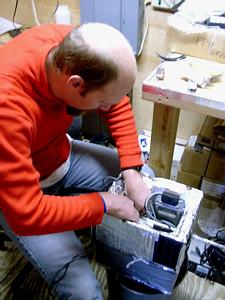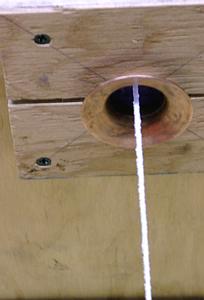14 December, 2000

The package is snug in its little aluminum covered styrofoam box about five feet below the Blimp. The temperature probe and the actual FPH sensor are located at the end of the boom.

Von was that secures the Blimp to the Helium bottle anchor. We have made our first successful instrumentation flight. A real plus to this flight was that during the maximum height portion, the weather station here at Pole released two different radiosondes to measure temp, humidity, and air pressure. These are the same measurements that we are taking and we will be able to compare our data to their data. Actually one of the big parts of our research is to show that the radiosonde data is in error. For example the radiosonde showed a relative humidity of only 17%. This is very unlikely since it was cloudy and snowing. Our instrument showed 100% relative humidity and in fact at some elevations supersaturation!

Today, like yesterday has been gray and cloudy. Lucky for the folks trying to leave it isn't so cloudy as to prevent flights in and out of the Pole like yesterday. One unusual thing about the weather is that it is snowing. From what the old timers have said, this is a heavy snow storm for the summer at the Pole. By Montana standards, I think it is about one flake a second! Seems like a very fine, cold snow, something that might cause a dusting after six hours or so, the kind that is so thin you might not even flick on the old wipers to get it off the windshield. In addition to the unusual event of snow we flew our Blimp with an instrument package for the first time this season. We flew the FPH and Air Pressure sensor that we set-up yesterday. Here you can see Von hooking the instrument package onto the tether line.

As the Blimp moves up into the cloud cover it gets harder and harder to see. Here it is at about its maximum height for this first flight at about 350 meters. As the Blimp moves up I let out the winch for one minute and then we allowed the instrument package to stabilize for 4 minutes before repeating the procedure. We let it out for an hour and fifteen minutes before bringing it back in using the same process. One minute of winch followed by four to stabilize. As soon as I can get a copy of the profile I will be sure to send it as an attachment.

As I was bringing down the Blimp it was interesting to see the frost that had formed on the tether line. It was amazing how much weight the frost added to the Blimp. Under normal conditions the Blimp would have gone much higher than 350 meters. Last season the Blimp went as high as 1.9 kilometers.
Contact the TEA in the field at
.
If you cannot connect through your browser, copy the
TEA's e-mail address in the "To:" line of
your favorite e-mail package.
|
